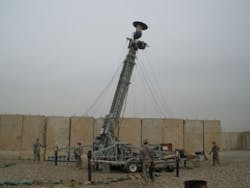Navmar to develop persistent-surveillance UAV and sensor payload for potential use in Afghanistan
Navy research project 92-170 refers to a laser detection and ranging (LADAR) identification demonstration, while Navy research project N94-178 refers to an air deployable expendable multi-parameter environmental probe. Air Force research project AF083-006 refers to low-cost intelligence, surveillance, and reconnaissance (ISR) UAV. On both contracts, Navmar will do the work in Afghanistan; Yuma, Ariz.; Patuxent River, Md.; Warminster, Pa.; and Johnstown, Pa.; and should be finished by July 2013.
Although it is not entirely clear from the contract announcements, it would appear that Navmar is developing a new persistent-surveillance and reconnaissance UAV with a LADAR payload.
LADAR sensors are notable for their ability essentially to see through camouflage, trees, and urban clutter by producing many different 2-D images from many different angles and collating these 2-D images into one 3-D picture. LADAR produces images of objects through holes and gaps in camouflage, trees, and urban clutter and then can put those images together in a composite picture to reveal what would be hidden in just one 2-D image.
For more information contact Navmar online at www.nasc.com, or the Naval Air Warfare Center Aircraft Division at www.navair.navy.mil/nawcad.
Related stories
-- Persistent surveillance on a non-satellite budget is goal of U.S. military airship development;
-- Persistent surveillance with UAV-mounted infrared sensors is goal of DARPA ARGUS-IR program; and
-- Navy eyes LADAR technology to detect and identify hostile aircraft for fleet defense.
